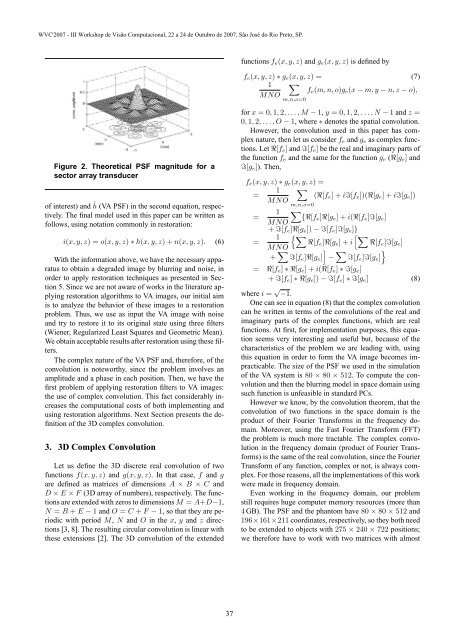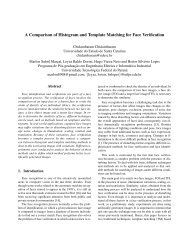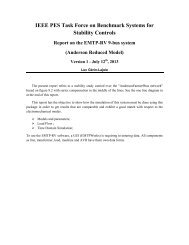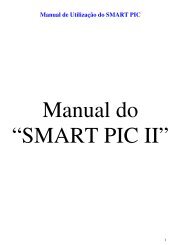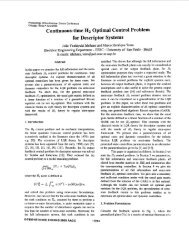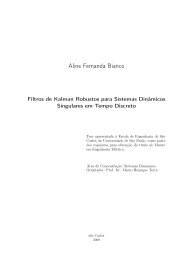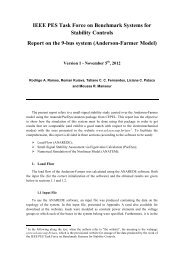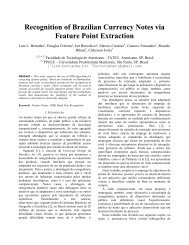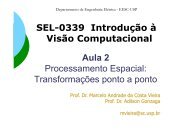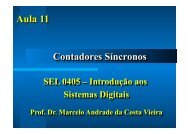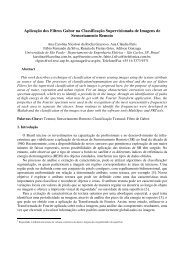<strong>WVC</strong>'<strong>2007</strong> - <strong>III</strong> Workshop de Visão Computacional, 22 a 24 de Outu<strong>br</strong>o de <strong>2007</strong>, São José do Rio Preto, SP.functions f e (x, y, z) and g e (x, y, z) is defined byFigure 2. Theoretical PSF magnitude for asector array transducerof interest) and ĥ (VA PSF) in the second equation, respectively.The final model used in this paper can be written asfollows, using notation commonly in restoration:i(x, y, z) =o(x, y, z) ∗ h(x, y, z)+n(x, y, z). (6)With the information above, we have the necessary apparatusto obtain a degraded image by blurring and noise, inorder to apply restoration techniques as presented in Section5. Since we are not aware of works in the literature applyingrestoration algorithms to VA images, our initial aimis to analyze the behavior of these images to a restorationproblem. Thus, we use as input the VA image with noiseand try to restore it to its original state using three filters(Wiener, Regularized Least Squares and Geometric Mean).We obtain acceptable results after restoration using these filters.The complex nature of the VA PSF and, therefore, of theconvolution is noteworthy, since the problem involves anamplitude and a phase in each position. Then, we have thefirst problem of applying restoration filters to VA images:the use of complex convolution. This fact considerably increasesthe computational costs of both implementing andusing restoration algorithms. Next Section presents the definitionof the 3D complex convolution.3. 3D Complex ConvolutionLet us define the 3D di<strong>sc</strong>rete real convolution of twofunctions f(x, y, z) and g(x, y, z). In that case, f and gare defined as matrices of dimensions A × B × C andD × E × F (3D array of numbers), respectively. The functionsare extended with zeros to dimensions M = A+D−1,N = B + E − 1 and O = C + F − 1, so that they are periodicwith period M, N and O in the x, y and z directions[3, 8]. The resulting circular convolution is linear withthese extensions [2]. The 3D convolution of the extendedf e (x, y, z) ∗ g e (x, y, z) = (7)1 ∑f e (m, n, o)g e (x − m, y − n, z − o),MNOm,n,o=0for x =0, 1, 2,...,M − 1, y =0, 1, 2,...,N − 1 and z =0, 1, 2,...,O− 1, where∗ denotes the spatial convolution.However, the convolution used in this paper has complexnature, then let us consider f e and g e as complex functions.Let R[f e ] and I[f e ] be the real and imaginary parts ofthe function f e and the same for the function g e (R[g e ] andI[g e ]). Then,f e (x, y, z) ∗ g e (x, y, z) =1 ∑=(R[f e ]+iI[f e ])(R[g e ]+iI[g e ])MNOm,n,o=01 ∑={R[fe ]R[g e ]+i(R[f e ]I[g e ]MNO+ I[f e ]R[g e ]) −I[f e ]I[g e ]}1{∑ [∑=R[fe ]R[g e ]+i R[fe ]I[g e ]MNO+ ∑ ]I[f e ]R[g e ] − ∑ }I[f e ]I[g e ]= R[f e ] ∗R[g e ]+i(R[f e ] ∗I[g e ]+ I[f e ] ∗R[g e ]) −I[f e ] ∗I[g e ] (8)where i = √ −1.One can see in equation (8) that the complex convolutioncan be written in terms of the convolutions of the real andimaginary parts of the complex functions, which are realfunctions. At first, for implementation purposes, this equationseems very interesting and useful but, because of thecharacteristics of the problem we are leading with, usingthis equation in order to form the VA image becomes impracticable.The size of the PSF we used in the simulationof the VA system is 80 × 80 × 512. To compute the convolutionand then the blurring model in space domain usingsuch function is unfeasible in standard PCs.However we know, by the convolution theorem, that theconvolution of two functions in the space domain is theproduct of their Fourier Transforms in the frequency domain.Moreover, using the Fast Fourier Transform (FFT)the problem is much more tractable. The complex convolutionin the frequency domain (product of Fourier Transforms)is the same of the real convolution, since the FourierTransform of any function, complex or not, is always complex.For those reasons, all the implementations of this workwere made in frequency domain.Even working in the frequency domain, our problemstill requires huge computer memory resources (more than4 GB). The PSF and the phantom have 80 × 80 × 512 and196×161×211 coordinates, respectively, so they both needto be extended to objects with 275 × 240 × 722 positions;we therefore have to work with two matrices with almost37
<strong>WVC</strong>'<strong>2007</strong> - <strong>III</strong> Workshop de Visão Computacional, 22 a 24 de Outu<strong>br</strong>o de <strong>2007</strong>, São José do Rio Preto, SP.48 million positions each. Since we are using complex values,each pixel demands 16 bytes to be stored in memory,so each matrix would need more than 762 MB to be stored.The method known as overlap-add was employed to tacklethis problem.4. Overlap-Add MethodThe overlap-add method [12] is used to reduce the a-mount of memory and computation required to convolvetwo functions and to perform the true linear convolution:the same requirements we have in our work. Since we areworking in 3D, we extend this method for our purposes.Suppose we want to convolve two functions, f(x, y, z)and g(x, y, z), as in Section 3. In the overlap-add method,f(x, y, z) is divided into segments f ijk (x, y, z), then thefunction f(x, y, z) can be represented by∑L 1∑L 2∑L 3f(x, y, z) =f ijk (x, y, z), (9)i=1 j=1 k=1where L 1 L 2 L 3 is the number of segments in the image.Convolving f(x, y, z) with g(x, y, z) and using the distributiveproperty of convolution, we obtainf(x, y, z) ∗ g(x, y, z) =(∑ L1∑L 2∑L 3)=f ijk (x, y, z) ∗ g(x, y, z)=i=1 j=1 k=1L 1 L 2 L 3∑ ∑ ∑(f ijk (x, y, z) ∗ g(x, y, z)). (10)i=1 j=1 k=1The segment f ijk (x, y, z) has a smaller support thanf(x, y, z), consequently the computation of the convolutionrequires less memory. The method makes the convolutionslowler, but the alternative is a series of input/outputoperations, which would be much less efficient.Once the problem of complex convolution is solved, wecan now apply the blurring model as shown in Section 2 andthen assess the restoration algorithms.5. RestorationImage restoration (or deconvolution) techniques removeor minimize some known degradations in an image [1, 10].In our case, the degradations of the VA image are caused bythe system PSF and the added Gaussian noise, both knownas we saw in the last Sections.For the purposes of this work, three well known filtersare applied: Wiener, Regularized Least Squares and GeometricMean. This choice was made because these arewidespread used filters and, moreover, there is the restrictionto work in frequency domain.The Fourier Transform of the restored image using theWiener Filter is given by[ 1 |H|ˆF 2 ]=H |H| 2 G, (11)+ Kwhere F , H and G are functions of (u, v, w), andK is aconstant. Using the Regularized Least Squares Filter[ 1 |H|ˆF 2 ]=H |H| 2 + γ|P | 2 G, (12)where γ is the regularization parameter and P (u, v, w)is the Fourier Transform of the 3D Laplacian Operator,p(x, y, z), givenby,⎡p(x, y, z) = ⎣⎡p(x, y, 2) = ⎣0 0 00 −1 00 0 0⎤⎦ ,z =1, 30 −1 0−1 6 −10 −1 0Using the Geometric Mean Filter{ [ ] H∗ α [HˆF ∗ ] } 1−α=H ∗ H H ∗ G. (13)H + γKThis last filter can be considered as an extended version ofthe Wiener Filter and, actually, its result lies between theWiener Filter and the Inverse Filter. Some initial tests withthe filters were made in Matlab and the final algorithmswere implemented in C.6. Experimental ResultsIn order to make our experimental tests, we used a digitalphantom (see Figure 3(a)), which was designed to mimicthe major features exhibited by the <strong>br</strong>east phantom shown inFigure 3(b). This phantom consists of three opaque spheresof radii 4, 3.5 and 3 mm, respectively. We are using a singleexperimental phantom instead of various phantoms or realimages, however controlled simulations and experimentsare necessary to evaluate the behavior of the method. Besides,making use of simulated images, we can control thenoise level and can evaluate the performance of the algorithmsusing images with different levels of additive andsignal independent noise.The VA image of the <strong>br</strong>east phantom is shown in Figure3(c), along with the region de<strong>sc</strong>ribed by the digitalphantom.We need the object function and the PSF to form theimage, so we use a di<strong>sc</strong>rete version of the phantom with196×161×211 pixels. The di<strong>sc</strong>rete version of the phantom⎤⎦38
- Page 1 and 2: III Workshop de VisãoComputacional
- Page 3 and 4: Instituto de Biociências, Letras e
- Page 5 and 6: WVC 2007 - III Workshop de Visão C
- Page 7 and 8: ApresentaçãoA área de Visão Com
- Page 10 and 11: Automatic Pattern Recognition of Bi
- Page 12 and 13: WVC'2007 - III Workshop de Visão C
- Page 14 and 15: WVC'2007 - III Workshop de Visão C
- Page 16: WVC'2007 - III Workshop de Visão C
- Page 19: WVC'2007 - III Workshop de Visão C
- Page 22 and 23: WVC'2007 - III Workshop de Visão C
- Page 24 and 25: WVC'2007 - III Workshop de Visão C
- Page 26 and 27: WVC'2007 - III Workshop de Visão C
- Page 28 and 29: WVC'2007 - III Workshop de Visão C
- Page 30 and 31: WVC'2007 - III Workshop de Visão C
- Page 33 and 34: WVC'2007 - III Workshop de Visão C
- Page 35 and 36: WVC'2007 - III Workshop de Visão C
- Page 37 and 38: WVC'2007 - III Workshop de Visão C
- Page 39 and 40: WVC'2007 - III Workshop de Visão C
- Page 41 and 42: WVC'2007 - III Workshop de Visão C
- Page 43 and 44: WVC'2007 - III Workshop de Visão C
- Page 45 and 46: WVC'2007 - III Workshop de Visão C
- Page 47: WVC'2007 - III Workshop de Visão C
- Page 51 and 52: WVC'2007 - III Workshop de Visão C
- Page 53 and 54: WVC'2007 - III Workshop de Visão C
- Page 55 and 56: WVC'2007 - III Workshop de Visão C
- Page 57 and 58: WVC'2007 - III Workshop de Visão C
- Page 59 and 60: WVC'2007 - III Workshop de Visão C
- Page 61 and 62: WVC'2007 - III Workshop de Visão C
- Page 63 and 64: WVC'2007 - III Workshop de Visão C
- Page 65 and 66: WVC'2007 - III Workshop de Visão C
- Page 67 and 68: WVC'2007 - III Workshop de Visão C
- Page 69 and 70: WVC'2007 - III Workshop de Visão C
- Page 71 and 72: WVC'2007 - III Workshop de Visão C
- Page 73 and 74: WVC'2007 - III Workshop de Visão C
- Page 75 and 76: WVC'2007 - III Workshop de Visão C
- Page 77 and 78: WVC'2007 - III Workshop de Visão C
- Page 79 and 80: WVC'2007 - III Workshop de Visão C
- Page 81 and 82: WVC'2007 - III Workshop de Visão C
- Page 83 and 84: WVC'2007 - III Workshop de Visão C
- Page 85 and 86: WVC'2007 - III Workshop de Visão C
- Page 87 and 88: WVC'2007 - III Workshop de Visão C
- Page 89 and 90: WVC'2007 - III Workshop de Visão C
- Page 91 and 92: WVC'2007 - III Workshop de Visão C
- Page 93 and 94: WVC'2007 - III Workshop de Visão C
- Page 95 and 96: WVC'2007 - III Workshop de Visão C
- Page 97 and 98: WVC'2007 - III Workshop de Visão C
- Page 99 and 100:
WVC'2007 - III Workshop de Visão C
- Page 101 and 102:
WVC'2007 - III Workshop de Visão C
- Page 103 and 104:
WVC'2007 - III Workshop de Visão C
- Page 105 and 106:
WVC'2007 - III Workshop de Visão C
- Page 107 and 108:
WVC'2007 - III Workshop de Visão C
- Page 109 and 110:
WVC'2007 - III Workshop de Visão C
- Page 111 and 112:
WVC'2007 - III Workshop de Visão C
- Page 113 and 114:
WVC'2007 - III Workshop de Visão C
- Page 115 and 116:
WVC'2007 - III Workshop de Visão C
- Page 117 and 118:
WVC'2007 - III Workshop de Visão C
- Page 119 and 120:
WVC'2007 - III Workshop de Visão C
- Page 121 and 122:
WVC'2007 - III Workshop de Visão C
- Page 123 and 124:
WVC'2007 - III Workshop de Visão C
- Page 125 and 126:
WVC'2007 - III Workshop de Visão C
- Page 127 and 128:
WVC'2007 - III Workshop de Visão C
- Page 129 and 130:
WVC'2007 - III Workshop de Visão C
- Page 131 and 132:
WVC'2007 - III Workshop de Visão C
- Page 133 and 134:
WVC'2007 - III Workshop de Visão C
- Page 135 and 136:
WVC'2007 - III Workshop de Visão C
- Page 137 and 138:
WVC'2007 - III Workshop de Visão C
- Page 139 and 140:
WVC'2007 - III Workshop de Visão C
- Page 141 and 142:
WVC'2007 - III Workshop de Visão C
- Page 143 and 144:
WVC'2007 - III Workshop de Visão C
- Page 145 and 146:
WVC'2007 - III Workshop de Visão C
- Page 147 and 148:
WVC'2007 - III Workshop de Visão C
- Page 149 and 150:
WVC'2007 - III Workshop de Visão C
- Page 151 and 152:
WVC'2007 - III Workshop de Visão C
- Page 153 and 154:
WVC'2007 - III Workshop de Visão C
- Page 155 and 156:
WVC'2007 - III Workshop de Visão C
- Page 157 and 158:
WVC'2007 - III Workshop de Visão C
- Page 159 and 160:
WVC'2007 - III Workshop de Visão C
- Page 161 and 162:
WVC'2007 - III Workshop de Visão C
- Page 163 and 164:
WVC'2007 - III Workshop de Visão C
- Page 165 and 166:
WVC'2007 - III Workshop de Visão C
- Page 167 and 168:
WVC'2007 - III Workshop de Visão C
- Page 169 and 170:
WVC'2007 - III Workshop de Visão C
- Page 171 and 172:
WVC'2007 - III Workshop de Visão C
- Page 173 and 174:
WVC'2007 - III Workshop de Visão C
- Page 175 and 176:
WVC'2007 - III Workshop de Visão C
- Page 177 and 178:
WVC'2007 - III Workshop de Visão C
- Page 179 and 180:
WVC'2007 - III Workshop de Visão C
- Page 181 and 182:
WVC'2007 - III Workshop de Visão C
- Page 183 and 184:
WVC'2007 - III Workshop de Visão C
- Page 185 and 186:
WVC'2007 - III Workshop de Visão C
- Page 187 and 188:
WVC'2007 - III Workshop de Visão C
- Page 189 and 190:
WVC'2007 - III Workshop de Visão C
- Page 191 and 192:
WVC'2007 - III Workshop de Visão C
- Page 193 and 194:
WVC'2007 - III Workshop de Visão C
- Page 195 and 196:
WVC'2007 - III Workshop de Visão C
- Page 197 and 198:
WVC'2007 - III Workshop de Visão C
- Page 199 and 200:
WVC'2007 - III Workshop de Visão C
- Page 201 and 202:
WVC'2007 - III Workshop de Visão C
- Page 203 and 204:
WVC'2007 - III Workshop de Visão C
- Page 205 and 206:
WVC'2007 - III Workshop de Visão C
- Page 207 and 208:
WVC'2007 - III Workshop de Visão C
- Page 209 and 210:
WVC'2007 - III Workshop de Visão C
- Page 211 and 212:
WVC'2007 - III Workshop de Visão C
- Page 213 and 214:
WVC'2007 - III Workshop de Visão C
- Page 215 and 216:
WVC'2007 - III Workshop de Visão C
- Page 217 and 218:
WVC'2007 - III Workshop de Visão C
- Page 219 and 220:
WVC'2007 - III Workshop de Visão C
- Page 221 and 222:
WVC'2007 - III Workshop de Visão C
- Page 223 and 224:
WVC'2007 - III Workshop de Visão C
- Page 225 and 226:
WVC'2007 - III Workshop de Visão C
- Page 227 and 228:
WVC'2007 - III Workshop de Visão C
- Page 229 and 230:
WVC'2007 - III Workshop de Visão C
- Page 231 and 232:
WVC'2007 - III Workshop de Visão C
- Page 233 and 234:
WVC'2007 - III Workshop de Visão C
- Page 235 and 236:
WVC'2007 - III Workshop de Visão C
- Page 237 and 238:
WVC'2007 - III Workshop de Visão C
- Page 239 and 240:
WVC'2007 - III Workshop de Visão C
- Page 241 and 242:
WVC'2007 - III Workshop de Visão C
- Page 243 and 244:
WVC'2007 - III Workshop de Visão C
- Page 245 and 246:
WVC'2007 - III Workshop de Visão C
- Page 247 and 248:
WVC'2007 - III Workshop de Visão C
- Page 249 and 250:
WVC'2007 - III Workshop de Visão C
- Page 251 and 252:
WVC'2007 - III Workshop de Visão C
- Page 253 and 254:
WVC'2007 - III Workshop de Visão C
- Page 255 and 256:
WVC'2007 - III Workshop de Visão C
- Page 257 and 258:
WVC'2007 - III Workshop de Visão C
- Page 259 and 260:
WVC'2007 - III Workshop de Visão C
- Page 261 and 262:
WVC'2007 - III Workshop de Visão C
- Page 263 and 264:
WVC'2007 - III Workshop de Visão C
- Page 265 and 266:
WVC'2007 - III Workshop de Visão C
- Page 267 and 268:
WVC'2007 - III Workshop de Visão C
- Page 269 and 270:
WVC'2007 - III Workshop de Visão C
- Page 271 and 272:
WVC'2007 - III Workshop de Visão C
- Page 273 and 274:
WVC'2007 - III Workshop de Visão C
- Page 275 and 276:
WVC'2007 - III Workshop de Visão C
- Page 277 and 278:
WVC'2007 - III Workshop de Visão C
- Page 279 and 280:
WVC'2007 - III Workshop de Visão C
- Page 281 and 282:
WVC'2007 - III Workshop de Visão C
- Page 283 and 284:
WVC'2007 - III Workshop de Visão C
- Page 285 and 286:
WVC'2007 - III Workshop de Visão C
- Page 287 and 288:
WVC'2007 - III Workshop de Visão C
- Page 289 and 290:
WVC'2007 - III Workshop de Visão C
- Page 291 and 292:
WVC'2007 - III Workshop de Visão C
- Page 293 and 294:
WVC'2007 - III Workshop de Visão C
- Page 295 and 296:
WVC'2007 - III Workshop de Visão C
- Page 297 and 298:
WVC'2007 - III Workshop de Visão C
- Page 299 and 300:
WVC'2007 - III Workshop de Visão C
- Page 301 and 302:
WVC'2007 - III Workshop de Visão C
- Page 303 and 304:
WVC'2007 - III Workshop de Visão C
- Page 305 and 306:
WVC'2007 - III Workshop de Visão C
- Page 307 and 308:
WVC'2007 - III Workshop de Visão C
- Page 309 and 310:
WVC'2007 - III Workshop de Visão C
- Page 311 and 312:
WVC'2007 - III Workshop de Visão C
- Page 313 and 314:
WVC'2007 - III Workshop de Visão C
- Page 315 and 316:
WVC'2007 - III Workshop de Visão C
- Page 317 and 318:
WVC'2007 - III Workshop de Visão C
- Page 319 and 320:
WVC'2007 - III Workshop de Visão C
- Page 321 and 322:
WVC'2007 - III Workshop de Visão C
- Page 323 and 324:
WVC'2007 - III Workshop de Visão C
- Page 325 and 326:
WVC'2007 - III Workshop de Visão C
- Page 327 and 328:
WVC'2007 - III Workshop de Visão C
- Page 329 and 330:
WVC'2007 - III Workshop de Visão C
- Page 331 and 332:
WVC'2007 - III Workshop de Visão C
- Page 333 and 334:
WVC'2007 - III Workshop de Visão C
- Page 335 and 336:
WVC'2007 - III Workshop de Visão C
- Page 337 and 338:
WVC'2007 - III Workshop de Visão C
- Page 339 and 340:
WVC'2007 - III Workshop de Visão C
- Page 341 and 342:
WVC'2007 - III Workshop de Visão C
- Page 343 and 344:
WVC'2007 - III Workshop de Visão C
- Page 345 and 346:
WVC'2007 - III Workshop de Visão C
- Page 347 and 348:
WVC'2007 - III Workshop de Visão C
- Page 349 and 350:
WVC'2007 - III Workshop de Visão C
- Page 351 and 352:
WVC'2007 - III Workshop de Visão C
- Page 353 and 354:
WVC'2007 - III Workshop de Visão C
- Page 355 and 356:
WVC'2007 - III Workshop de Visão C
- Page 357 and 358:
WVC'2007 - III Workshop de Visão C
- Page 359 and 360:
WVC'2007 - III Workshop de Visão C
- Page 361 and 362:
WVC'2007 - III Workshop de Visão C
- Page 363:
WVC'2007 - III Workshop de Visão C


